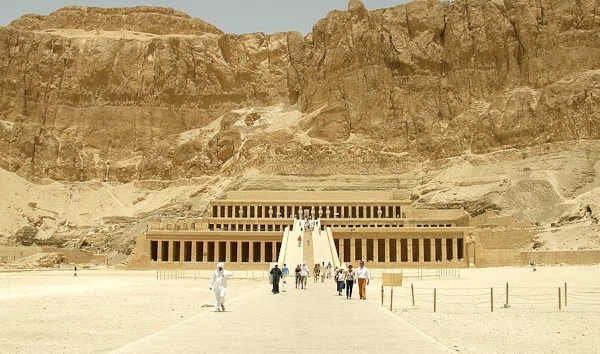Archaeologists have discovered an ancient tomb containing 11 sealed burials near the legendary historical site of Luxor, Egypt. They also found an impressive collection of grave goods in the tomb, highlighting the wealth of the individuals who were buried there.
The tomb, dating back to the Middle Kingdom (1938–1630 BC), was unearthed in the South Asasif necropolis, with coffins for men, women, and children. Potentially, the site may have served as a family tomb over several generations through the 12th and early 13th Dynasties.
The finds were made by a joint-archaeological mission of Egyptian and US archaeologists, according to a press release by the South Asasif Conservation Project. The newly discovered tomb is located near the Temple of Hatshepsut on Luxor’s West Bank, and this is the first Middle Kingdom tomb discovered in this area.
“The unearthing of the first Middle Kingdom tomb in the South Asasif necropolis alters its history, placing South Asasif within the sprawling Theban Middle Kingdom necropolis,” said Katherine Blakeney, the lead American archaeologist working at the site. “Further exploration of the Middle Kingdom burials in the South Asasif necropolis will significantly advance our ongoing research on Middle Kingdom influences on the art and funerary rituals of the Twenty-fifth Dynasty.”
Intact Despite the Flood: A Beautiful Array of Artifacts
Many of the tomb’s original wooden coffins and linen wrappings were destroyed by ancient floods, but some items remained intact, including jewelry from women’s burials: these include an amethyst necklace featuring 30 beads, as well as two cylindrical agate beads and a hippo-head amulet, as detailed in the statement.

Beaded jewelry and copper alloy mirror with ivory handle found in Middle Kingdom tomb at Luxor. (South Asasif Conservation Project).
Katherine Blakeney highlighted other artifacts discovered during the South Asasif excavations, including two copper mirrors—one with a lotus-shaped handle and another with an image of Hathor, the goddess of the sky, women, fertility, and love.
“Such craftsmanship underscores the cultural and artistic sophistication of the Middle Kingdom,” she mused.
Other phenomenal finds include a green-blue faience fertility figurine with truncated legs, adorned with jewelry-like markings, and a square offering tray featuring reliefs of a bull’s head, a loaf of bread, and other offerings, reports The Times of Israel. The figurine is adorned with various jewelry and features lozenge-shaped markings on its legs and torso. Its cropped hair is painted black, and the head is pierced with holes arranged in three sections, designed to attach “hair.” Nearly 4,000 mud beads found nearby originally constituted her hair.

Fertility figurine recovered from newly discovered Middle Kingdom tomb in Luxor. (South Asasif Conservation Project).
An associated offering tray is square-shaped with a low border and a central water channel, surrounded by reliefs depicting offerings. These include a bull’s head, ribs, a leg, a loaf of bread, and other symbolic items, perhaps used in a ritual sense.
All in all, the remains of 11 individuals were discovered within the burials. Dr. Afaf Wahba, a team member, identified five women, two men, and three children, with six of the women buried alongside burial assemblages. Most of the bodies were laid side-by-side in wooden coffins positioned north to south, with heads facing in alternating directions.
Most of the jewelry was associated with female burials, while the children and one of the men were found without any burial items. Another striking necklace was discovered on one of the interred men – a piece featuring 40 faience ball beads separated by single faience cylinder beads, with two carnelian cylinder beads framing a hippo-head amulet at the back.
Tourism Starved: A Sputtering Economy
The discovery comes as Egypt ramps up efforts to draw more tourists—a crucial source of foreign income for the nation’s economy. Tourism, which at its peak in 2010 accounted for about 12% of Egypt’s workforce, has been impacted by the political unrest of 2011 and later by the COVID-19 pandemic. The country is working to revitalize the sector and has invested in archaeology and research projects to spotlight Egypt’s historical treasures, reports Archaeology Mag.
In another major development last month, the Grand Egyptian Museum near the Giza Pyramids opened 12 halls for visitors as a preview, while the official opening is expected soon. This new museum is anticipated to draw significant global interest and contribute to Egypt’s tourism resurgence.
Luxor, with its unparalleled wealth of ancient monuments like the Karnak Temple and Luxor Temple, as well as the Valley of the Kings and Queens, is a focal point of these efforts. Investments in archaeological research, preservation, and high-profile projects are underway to restore ‘lost pride’ and bring more visitors to one of the most remarkable historical locations in all of the world.
Top image: Temple of Hatshepsut in Luxor, Egypt. Source: Vyacheslav Argenberg/CC BY-SA 4.0.
By Sahir Pandey






